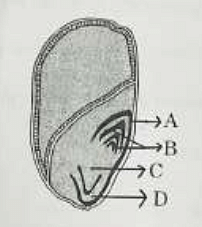Question:
Given below are two statements:
Statement (I): The non deep type is the most common primary dormancy
Statement (II): In this type of dormancy species require light or darkness to germinate or chilling stratification
In light of the above statements, choose the most appropriate answer from the options given below
Given below are two statements:
Statement (I): The non deep type is the most common primary dormancy
Statement (II): In this type of dormancy species require light or darkness to germinate or chilling stratification
In light of the above statements, choose the most appropriate answer from the options given below
Statement (I): The non deep type is the most common primary dormancy
Statement (II): In this type of dormancy species require light or darkness to germinate or chilling stratification
In light of the above statements, choose the most appropriate answer from the options given below
Show Hint
Seed dormancy ensures germination at the right time.
Non-deep dormancy: Common, embryo is developed. Broken by conditions like light, after-ripening (dry storage), or alternating temperatures.
Deep dormancy: Requires more specific, often prolonged treatments like chilling stratification (moist cold). Statement II incorrectly groups chilling stratification with common requirements for non-deep dormancy.
Non-deep dormancy: Common, embryo is developed. Broken by conditions like light, after-ripening (dry storage), or alternating temperatures.
Deep dormancy: Requires more specific, often prolonged treatments like chilling stratification (moist cold). Statement II incorrectly groups chilling stratification with common requirements for non-deep dormancy.
Updated On: Jun 3, 2025
- Both Statement (I) and Statement (II) are true.
- Both Statement (I) and Statement (II) are false.
- Statement (I) is true but Statement (II) is false.
- Statement (I) is false but Statement (II) is true.
Hide Solution
Verified By Collegedunia
The Correct Option is C
Solution and Explanation
Let's evaluate each statement about seed dormancy:
Statement (I): The non deep type is the most common primary dormancy.
Primary dormancy is a state where a seed is unable to germinate even under favorable conditions, right after it is shed from the parent plant. Non-deep physiological dormancy is indeed a very widespread type of primary dormancy across many plant species. It means the embryo is developed, but germination is inhibited by factors within the seed itself. This statement is generally considered true.
Statement (II): In this type of dormancy [non-deep type] species require light or darkness to germinate or chilling stratification.
Non-deep physiological dormancy can be broken by various environmental cues. Some species with this dormancy type do require specific light conditions (either presence or absence of light) for germination. However, "chilling stratification" (a period of moist cold treatment) is primarily a requirement for breaking *deep* physiological dormancy or certain types of morphophysiological dormancy. While some non-deep dormancies might be overcome by mild temperature fluctuations or dry after-ripening, extensive chilling stratification is not a characteristic requirement for all or even most non-deep dormancies. Therefore, including chilling stratification as a general requirement for breaking non-deep dormancy makes Statement (II) false.
Since Statement (I) is true and Statement (II) is false, the correct option is (3).
Statement (I) is true but Statement (II) is false.
Was this answer helpful?
0
0
Top Questions on The Seed
- In the seeds of cereals, the outer covering of endosperm separates the embryo by a protein-rich layer called:
- What is the ideal seed rate for okra for rainy season crop?
- Which of the following is true for essentiality of germination? (A) Viability of seed
(B) Proper environment
(C) Seed free from dormancy
(D) Thin seed coat - Which of the following annuals require the isolation distance of 50-100 meters for seed production?
(A) Antirrhinum
(B) Marigold
(C) Larkspur
(D) Nasturtium
Choose the correct answer from the options given below: Identify the part of the seed from the given figure which is destined to form root when the seed germinates.

View More Questions
Questions Asked in ICAR AIEEA exam
- Which fiber is known for its excellent moisture-wicking properties, making it ideal for active wear?
- Which is NOT a feature of a cooperative society?
- ICAR AIEEA (PG) - 2025
- Marketing
- Which is the recommended protein level for carp grow-out feed?
- ICAR AIEEA (PG) - 2025
- Fish Nutrition
- The 'Law of the Minimum' was proposed by:
- ICAR AIEEA (PG) - 2025
- Agronomic Principles
- In the context of agribusiness, SWOT analysis is used to assess:
- ICAR AIEEA (PG) - 2025
- Principles and Functions of Management
View More Questions